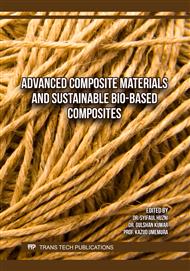p.17
p.23
p.31
p.39
p.47
p.55
p.65
p.71
p.81
The Effect of Number of Laminate Layers on the Ramie E-Glass Fiber Hybrid Composite for Jaloe kayoh Material
Abstract:
The objective of this research is to investigate how the quantity of laminate layers impacts the Ramie-Eglass fiber hybrid composite utilized in the Jaloe Kayoh material, specifically concerning mechanical properties such as tensile strength and flexural properties. In this research, the authors conducted tensile and flexural testing on composites with varying quantities of laminate layers. The research findings indicate that incorporating a laminate layer into the hybrid composite positively affects its mechanical properties. The composites with 5 laminate layers had the maximum tensile strength, measuring approximately 59.79 MPa, and the highest tensile modulus, measuring around 3.15 GPa. The results suggest that adding a suitable number of laminate layers can enhance the composite's resistance to tensile stress and preserve its structural stiffness. Furthermore, the composite consisting of 6 laminate layers demonstrated the largest elongation at break, measuring at 2.04%. This result suggests that the material has a commendable ability to withstand strain before reaching its breaking point. For flexural properties, the configuration with 3 layers of lamina shows the most optimal results with flexural strength of around 161.11 MPa, flexural strain of around 0.021, and flexural modulus of around 3.47 GPa. Therefore, this configuration is recommended as the most optimal to withstand flexural stress on Jaloe Kayoh. This study offers valuable insights into the correlation between the quantity of laminate layers and the mechanical properties of Ramie-Eglass fiber hybrid composites. These insights can be utilized to create advanced composite materials for Jaloe Kayoh boats.
Info:
Periodical:
Pages:
47-54
Citation:
Online since:
May 2025
Price:
Сopyright:
© 2025 Trans Tech Publications Ltd. All Rights Reserved
Share:
Citation:



